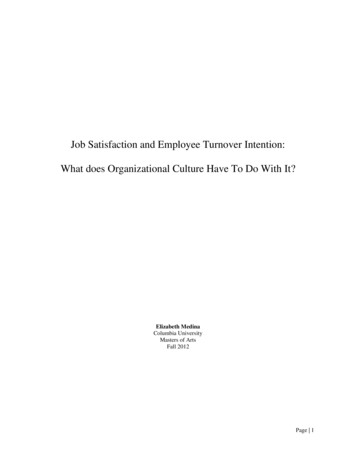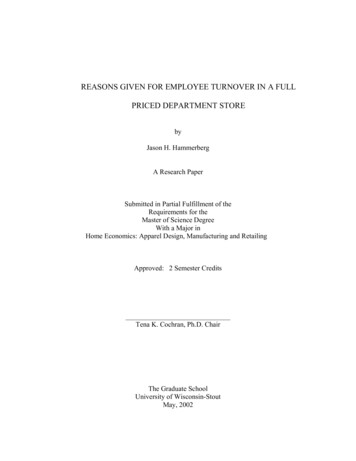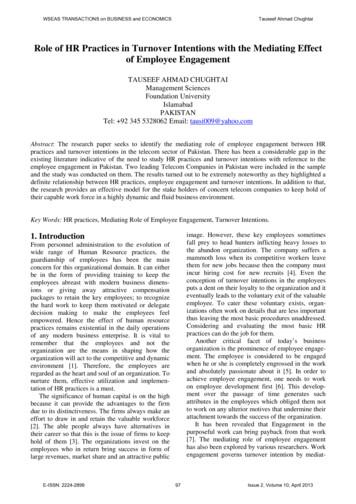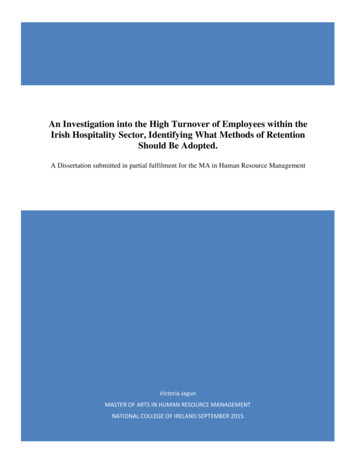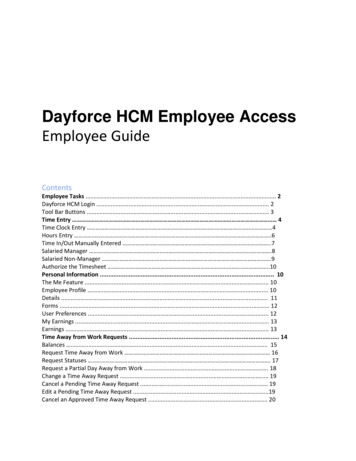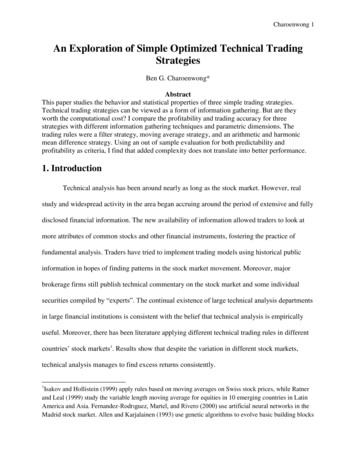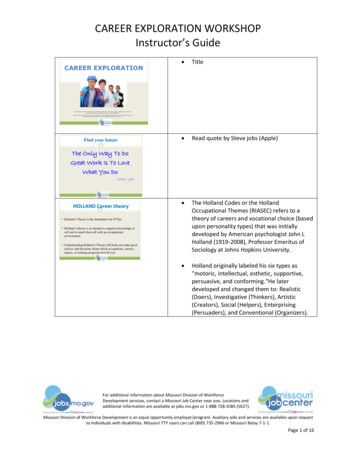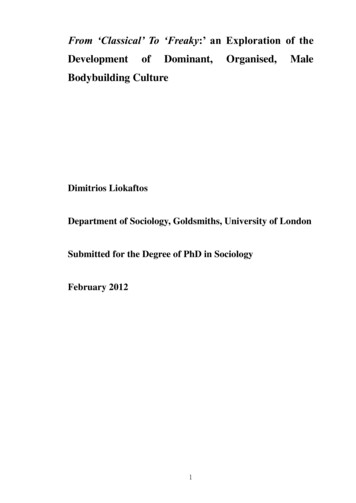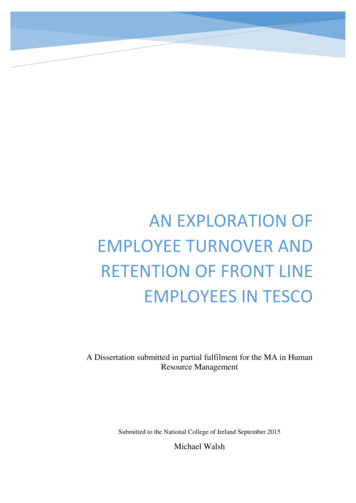
Transcription
AN EXPLORATION OFEMPLOYEE TURNOVER ANDRETENTION OF FRONT LINEEMPLOYEES IN TESCOA Dissertation submitted in partial fulfilment for the MA in HumanResource ManagementSubmitted to the National College of Ireland September 2015Michael Walsh
AbstractThis research study was conducted to explore the issue of employee turnover and retention offront line employees in the Irish retail sector, using Tesco Ireland as the context. The data wascollected from front line employees of Tesco to ensure results were precise and adequate. Theauthor conducted examined a list of different theories relating to turnover and retention toprovide a foundation for the research. To explore the main issue, sub research questions weredevised based on the literature and these related to effects of turnover, career advancement,communication, supervisor/employee relationship and workplace stress. The research wascarried out using the mixed methods approach – questionnaire (44 respondents) and structuredinterview (6 interviewees). The findings revealed that Tesco have the capabilities to deal withturnover and retention with regards to the effects of turnover, career advancement,communication, supervisor/employee relationship and workplace stress however there areminor flaws that can be addressed.1
Submission of Thesis and DissertationNational College of IrelandResearch Students Declaration Form(Thesis/Author Declaration Form)Name: Michael WalshStudent Number: x11528487Degree for which thesis is submitted: MA in Human Resource ManagementMaterial submitted for award(a) I declare that the work has been composed by myself.(b) I declare that all verbatim extracts contained in the thesis have been distinguishedby quotation marks and the sources of information specifically acknowledged.(c) My thesis will be included in electronic format in the CollegeInstitutional Repository TRAP (thesis reports and projects)(d) Either *I declare that no material contained in the thesis has been used in any othersubmission for an academic award.Or *I declare that the following material contained in the thesis formed part of asubmission for the award of(State the award and the awarding body and list the material below)Signature of research student: Michael WalshDate: 2nd September 20152
Submission of Thesis to Norma Smurfit Library, National College of IrelandStudent name: Michael Walsh Student number: x11528487School: School of Business Course: MAHRMDegree to be awarded: MA in Human Resource ManagementTitle of Thesis: An Exploration of Employee Turnover and Retention of Front Line Employees in TescoOne hard bound copy of your thesis will be lodged in the Norma Smurfit Library and will be available for consultation. The electroniccopy will be accessible in TRAP (http://trap.ncirl.ie/), the National College of Ireland’s Institutional Repository. In accordance withnormal academic library practice all theses lodged in the National College of Ireland Institutional Repository (TRAP) are madeavailable on open access.I agree to a hard bound copy of my thesis being available for consultation in the library. I also agree to an electronic copy of my thesisbeing made publicly available on the National College of Ireland’s Institutional Repository TRAP.Signature of Candidate: Michael WalshFor completion by the School:The aforementioned thesis was received by Date:This signed form must be appended to all hard bound and electronic copies of your thesis submitted to your school3
AcknowledgementsWithout the help and support of the following people, I think I would have found it difficult tobe at this stage of my academic career.Firstly, I would like to thank my supervisor Jonathan Brittain for giving me the help andguidance to complete this thesis. Without his input, I think I would’ve found it a lot moredifficult to complete.I’d also like to thank the employees who gave up their spare time to participate in my researchstudy and provide the data that made this all possible.To my friends who helped me find the little mistakes.To my family who have been there for me when things got tough.Lastly, Kim who has encouraged me since day one when I began my first business PLC course.Each and every one of your help has been greatly appreciated.4
Contents PagePg.1 – Introduction82 – Literature Review92.1– Introduction92.2 – Problems of Turnover102.3 – Benefits of Turnover122.4 – Characteristics of High Turnover Environment132.5 – Characteristics of Effective Retention172.6 – Barriers to Retention193 – Research Questions213.1 – Research Question 1213.2 – Research Question 2213.3 – Research Question 3223.4 – Research Question 4223.5 – Research Question 5224 – Research Methodology234.1 – Introduction234.2 – Research Philosophy234.3 – Research Approaches244.4 – Research Design and Methodology244.4.1 – Research Strategies244.4.2 – Research Choices254.4.3 – Research Time Horizons264.4.4 – Research Data Collection and Analysis275
4.4.4.1 – Questionnaire Design274.4.4.2 – Interview Design294.5 – Validity & Reliability304.6 – Questionnaire Administration314.7 – Interview Administration314.8 – Sample324.8.1 – Sample Size324.8.2 – Sample Technique324.9 – Ethical Considerations334.10 – Limitations355 – Findings365.1 – Quantitative Findings365.1.1 – Section 1 – Demographics365.1.2 – Section 2 – Effects of Turnover on Staff385.1.3 – Section 3 – Career Advancement435.1.4 – Section 4 – Communication485.1.5 – Section 5 – About Your Supervisor/Manager535.1.6 – Section 6 – Workplace Stress595.1.7 – Section 7 – Positives and Negatives of Tesco645.2 – Qualitative Findings665.2.1 – Section 1 – Effects of Turnover on Staff665.2.2 – Section 2 – Career Advancement675.2.3 – Section 3 – Communication695.2.4 – Section 4 – About Your Supervisor/Manager706
5.2.5 – Section 5 – Workplace Stress725.2.6 – Section 6 – Positives and Negatives of Tesco736. Analysis and Discussion756.1 – Research Questions756.2 – Effects of Turnover on Staff756.3 – Career Advancement776.4 – Communication796.5 – Supervisor/Manager Relationship816.6 – Workplace Stress847 – Conclusion877.1 – Conclusion877.2 – Scope for Further Studies898 – Recommendations and Costing’s909– Personal Learning Statement9210 – Reference List9311 – Appendix967
1 – IntroductionAccording to Bersin (2013), as the economy is beginning to improve, employee retention issuesare beginning to arise and this very issue highlights that company’s employee turnover andretention strategies will be tested again. The perception of the retail sector wasn’t particularlyinviting to potential employees due to various factors including low wages, the work is toughwith bad work shifts, and it is general regarded as a dead end job with little chance of careerdevelopment. However, Jones (1994) says that retail sector offers an early opportunity toexperience responsibility without having the need to have years of experience that is normallyrequired for such management jobs. Jones (1994) stated that graduates were recruited formanagement positions and believed that the one thing that their company pushes when they goto college campuses, is that retail is a good career path that offers early responsibility and arehired for the potential of their contribution. Similarly, Wrice (2004) believes that the retailsector is beginning to shed the negative perception that plagues it, however it will be difficultto have a completely positive image. He believes that companies have now started to realisethat retailing calls for people with special skills, including high people skills leading to highersalary. Secondly, companies in the retail sector have introduced career development training,including traineeships. With this perception changing to a more positive view, this will attractmore highly skilled employees interested in joining the company. This brings about thequestion of how do we satisfy their needs and ensure that they remain with us. As thisperception is changing, this will increase the chance of attracting potential employees and leadto the next challenge of retaining them. This involves dealing with a whole new set of problemsincluding morale, career advancement, communication, supervisor/employee relationship andworkplace stress (Nikravin and Frauenheim, 2014), (Werbel and Bedeian, 1989), (Burton2006), (Buckingham, 2000), (Blaug, Kenyon and Lekhi, 2007).The main aim of this study will be to explore the issue of employee turnover and retention offront line employees in the Irish retail sector, using Tesco Ireland as the context, and discoverwhether Tesco have sufficient retention policies that allow them to retain their front lineemployees. This will be achieved through the use of both quantitative and qualitative researchmethods, the questionnaire and structured interview, which will provide a broad range of datawhich can be analysed to decide whether Tesco can deal with turnover and retention. Thesemethods will be conducted with assistance from selected members of the Tesco Irelandworkforce to ensure data is precise and adequate.8
What helps to make this a worthy topic is that it is not always the same factors relating to eachcompany. Compensation may be the main factor that hinders employee retention in onecompany, whereas poor career development could be the main factor in another. This in itselfprovides gaps in research as each company is judged on an individual basis, making themunique.2 – Literature Review2.1 - IntroductionAccording to the CIPD (2014) Employee turnover refers to “the proportion of employees wholeave an organisation over a set period (often on a year-on year basis), expressed as apercentage of total workforce numbers” and that “employee retention relates to the extent towhich an employer retains its employees and may be measured as the proportion of employeeswith a specified length of service (typically one year or more) expressed as a percentage ofoverall workforce numbers”.Figuring out turnover rates can be simple but by focusing on the turnover aspect, this can lessenthe ability to gain more prominent information. There is a formula that can be used bycompanies to accurately measure the turnover rate amongst their workforce which is: Turnoverrate Number of terminations per year Average active employees same year * 100(O’Connell and Kung, 2007).Likewise, a stability index can be used to measure the retention rate of employees who aredeemed experienced, with one or more years with the company. This can be calculated by:Retention rate Number of staff with service of one or more year’s Total number of staff inpost one year ago * 100 (CIPD, 2014).According to Taylor (2002), the reason that employee turnover occurs, falls into four sectionswhich are pull factors, push factors, unavoidable factors and organisational influence. Pull typeturnover happens due to the employee being enticed by an alternative job elsewhere. This isnot down to such reasons such as job satisfaction as the employee may be happy with thecompany, but this new opportunity could lead to better salary and benefits. Push type turnoverhappens because of how the employee views their employer. This can lead to employeesleaving the company to find, by their own views, a better working environment. Unavoidableturnover happens because of reasons that are beyond the control of the company. The factors9
involved in this has nothing to do with the previous push and pull factors, but more so to dowith factors that aren’t work relate that includes retirements, illnesses and maternity leave,should they choose not to return to their jobs. Involuntary turnover occurs due to directcompany involvement. The company asks employees to leave or decides not to renew theircontracts.2.2 – Problems of TurnoverThe results of staff turnover are not always believed to be negative, sometimes even leading topositive outcomes, however they still have the potential to pose serious problems to mostcompanies (Morris & Hodgins, 2000).2.2.1 – Replacement CostIf an employee decides to leave the company, it is not only the employee that you lose. It alsoinvolves the loss of money and time spent identifying, interviewing and the training of thatspecific employee, as well as the skills they have learned from working in that company, whichin turn leads to further costs finding a replacement (Bruce, 1988).A study by Cascio (2000,cited in Brotherton, 2010) found that the full cost of turnover can lead to 93 to 200% of theemployee’s salary that has left. However, Taylor (2002) believed that this can depend on whattype of position is to be filled. If it is possible to replace this person quickly and you can havetheir productivity levels up to a reasonable standard, then costs may be less expensive, but ifthe person is highly skilled and these skills are short in supply, then this is where the cost comesfrom through expertise and loss of knowledge.This view is agreed also by O’Connell and Kung (2007). They believe that the replacementcosts that arise from turnover can be divided into three parts. Staffing, which involves the costof identifying and hiring the employee who has left alongside the cost of hiring a newemployee, vacancy is the amount of time that the position is left idle, resulting in productivitybeing negatively affected, and training as the new employees have to accumulate theirproductivity which can take some time. Along with these three areas, the CIPD (2014) believethe administration of the resignation is another area of cost that can be accounted for.2.2.2 – Loss of key knowledge or skillsThe consequences of employees leaving can result in the loss of key knowledge and skillswithin the company. DeLong (2004, p.21) states “lost knowledge means the decreased10
capacity for effective action or decision making in specific in a specific organisationalcontext”.
The main aim of this study will be to explore the issue of employee turnover and retention of front line employees in the Irish retail sector, using Tesco Ireland as the context, and discover whether Tesco have sufficient retention policies that allow them to retain their front line employees. This will be achieved through the use of both quantitative and qualitative researchFile Size: 1MBPage Count: 133
